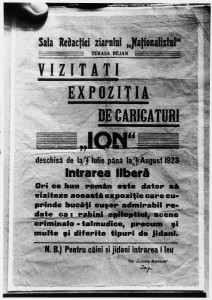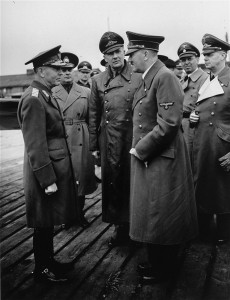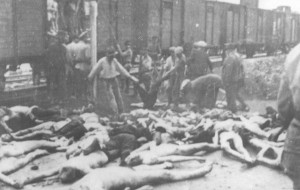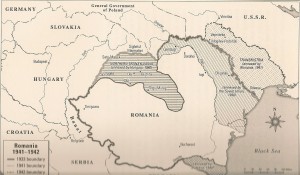About the Book
Based on actual events, Ada Nicolescu’s painstakingly researched sequel to Prelude in Black and Green reveals how in Romania the leaders’ thirst for power and the country’s alliance with Germany contributed to a brutal, unruly genocide of victimization, intimidation, mass murders and deportation. The latter often resulted in interminable marches and the notorious death trains.
At the same time, “The Black and The Green” resurrects an important but often overlooked story—that of the heroic Jewish underground resistance and its daring but dangerous plan to save the Jewish community from extermination. The author recounts, in moving detail, its valiant struggle against overwhelming odds and the remarkable courage its supporters exhibited to save many thousands of Jews— particularly children—as they were heartlessly uprooted from the place they had once called home.

An ad for an exhibit of anti-Semitic drawings reads in part: “Any good Romanian must visit this exhibition which has kosher pieces .. such as: epileptic rabbis, criminal-talmudic scenes and …. N.B. Entrance is 1 lei for dogs and kikes.”

Romanian dictator, Marshal Ion Antonescu (left), converses with Adolf Hitler during an official visit to Germany, as Nazi officials look on.

Romanian police supervise the removal of bodies from the Iasi-Calarasi death train bound for concentration camps in Transnistria.
The List of Characters
The Stein Family
Adrian Stein……………………….. Electrical Engineer, 44.
Nina…………………………………… His Wife, 40.
Suzy…………………………………… Daughter, 17.
Nadia…………………………………. Daughter, 12.
Nina’s Relatives (all maternal)
Aunt Josephine Gold…………. Nina’s mother’s youngest sister, 68.
Uncle Leon Gold………………… Her husband, 74.
Joel Gold……………………………. Their son, Pediatrician, 32.
Mathilda Gold…………………….. Joel’s wife, 26.
Stella Frühling…………………… Nina’s sister, 36.
Sorel Frühling……………………. Stella’s husband, Pediatrician, 39.
Others
Zalman Bier……………………….. President of the Jewish Community, Istanbul, 56.
Domnişoara Braunstein…….. Adrian’s Secretary, 31.
Sigmund Dorfman…………….. President of the Jewish Community, Moghilev, 47.
Dorothea……………………………. Nadia’s friend, 12.
Gary Fisher………………………… Assistant to Professor Glassbein, 25.
Fritz……………………………………. Adrian’s chauffeur, 45.
Captain Garapnik………………. Ship’s captain, The Dorina, 49.
Captain Zelea Codreanu…… Founder, Fascist Legionnaire Organization, the Iron Guard
Dr. Victor Georgescu………….. Psychiatrist, Director of the Mental Hospital, 58.
Professor Herman Glassbein Principal, Jewish Boys’ School, 52.
Professor Anna Glassbein…. His wife, Principal, Jewish Girls’ School, 50.
Boris Guttman……………………. Polish refugee, 17.
Rachel Guttman………………… His sister, 11.
Horaţiu……………………………….. Leader of the Fascist Legionnaire Organization, the Iron Guard, 32.
Dr. Ionescu………………………… Physician, Adrian’s neighbor, Legionnaire.
Charles Kass……………………… Electrical Engineer in Switzerland, member, International Red Cross, 45.
Chaim Labras…………………….. President of the Jewish Agency in Palestine, 48.
The Mareshal…………………….. Prime Minister of Romania, 45.
Serge Miller………………………… President of the Jewish Community of Switzerland, Representative of the American Joint Distribution Committee of Europe, 37
Dr. Eugen Milo…………………… Psychiatrist, Assistant to Dr. Georgescu, Legionnaire leader, 31.
Nissim………………………………… First Mate, the DORINA, 28.
Rabbi Alexander Naftali…….. Chief Rabbi of Romania, 46.
Paul Radin…………………………. Romanian Diplomat, 61.
Silvia………………………………….. Dr. Milo’s fiancee, member of Legionnaire Organization, the IRON GUARD, 27. Has been Suzy and Nadia’s governess.
Professor Gheorghe Ursu….. Physician, Dean, Bucharest School of Medicine, 45.
Hans Waldo……………………….. Journalist, Courier for the Swiss Embassy in Bucharest, 26.
Max Wiener………………………… Famous Jewish Historian, 75.
An Excerpt
When he got off the train and went to hail a taxi, Sorel was surprised by the number of troops and military vehicles in the streets. There seemed to be a nervous mood in the air, a sort of agitation, which he attributed to the great military concentration, and to the fact that he was so close to the frontline—only six kilometers beyond the outskirts of the town.
The ride to his sister’s house, the old home of his parents on Păcurari Street in an affluent Jewish section of the city near the Copou Gardens, took much longer than usual. Many streets were closed. He saw many destroyed and damaged buildings. The taxi driver told him they had all been ruined in a heavy Soviet bombardment only two nights ago on the 26th. Official buildings had been razed by the bombs and many people had died in the attack. The air was still filled with dust and smoke. He felt that the fragrance of the linden blooms was replaced with an acrid, nauseating odor.
When he arrived at the old home, Sorel was warmly hugged and greeted by his sister, Diana, and her husband, Marcu. He was led to his old room where he left his valise and jacket. A few minutes later, over a glass of hot tea from the samovar and dry cookies served with cherry preserve, he noticed that both his sister and her husband seemed nervous and looked very pale. They had lost weight since he had last seen them. They had dark shadows under their eyes. There was also more gray now in Marcu’s hair.
They tried to smile as they inquired about Sorel’s family in Bucharest, but they fell silent after a few words. They seemed preoccupied.
Finally, after Sorel asked them about themselves, Diana told him that weird and serious things were happening in Iaşi proper and in the surrounding areas.
It had all started suddenly, ten days earlier, even before the beginning of the war, she said. On that day, at the crack of dawn, soldiers and policemen came to the house of her husband’s family in S and ordered them to pack their bags and report to the railway station before 7 o’clock in the morning. All the Jews from that community and from other communities near the river Prut were evacuated by train to unknown destinations.
Her husband Marcu had gone to the Rabbi to find out more information. He only told Marcu that the Jews had been officially evacuated to assure the security of the frontline. But he didn’t know where they were.
“The mood in Iaşi proper is very tense,” she added. Marcu then told him the same thing the taxi driver had already told him. Namely, two days earlier, on June 26, the city had suffered a severe Russian bombardment which had caused heavy damage and killed many people. A number of official buildings had been destroyed during the bombardment. Unfortunately, soon after the attack, rumors had started that the Jews had been sending signals to the Russian pilots (who themselves were nothing more than other Jews from Iaşi) directing them where to drop their bombs.
An article in the newspaper claimed that a Jewish baker from Iaşi and a female Jewish medical student, also from Iaşi, had been identified among the downed Russian paratroopers. Other paratroopers and pilots from Russian planes which had been shot down were never found: They were obviously hidden and protected by their fellow Jews in the city—all in the service of the Soviets and sending signals to the planes. These signals consisted of messages from radio-emission sets hidden inside Jewish apartments, attics and cellars. Other “special” signals had been transmitted with the help of red light bulbs and flashlights, or with colored clothing, blankets and underwear which hung on clotheslines on Jewish rooftops.
“I know that all this sounds ridiculous, but the newspapers and the radio spread these rumors, and the people believe them!” said Marcu. He then took Sorel across the street and showed him a large poster with the handwritten words: “Romanians! With each kike you murder, you kill a communist. The moment of vengeance has arrived.”



Leave a Reply